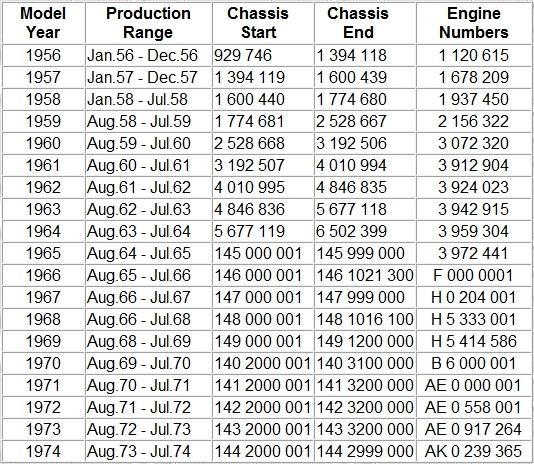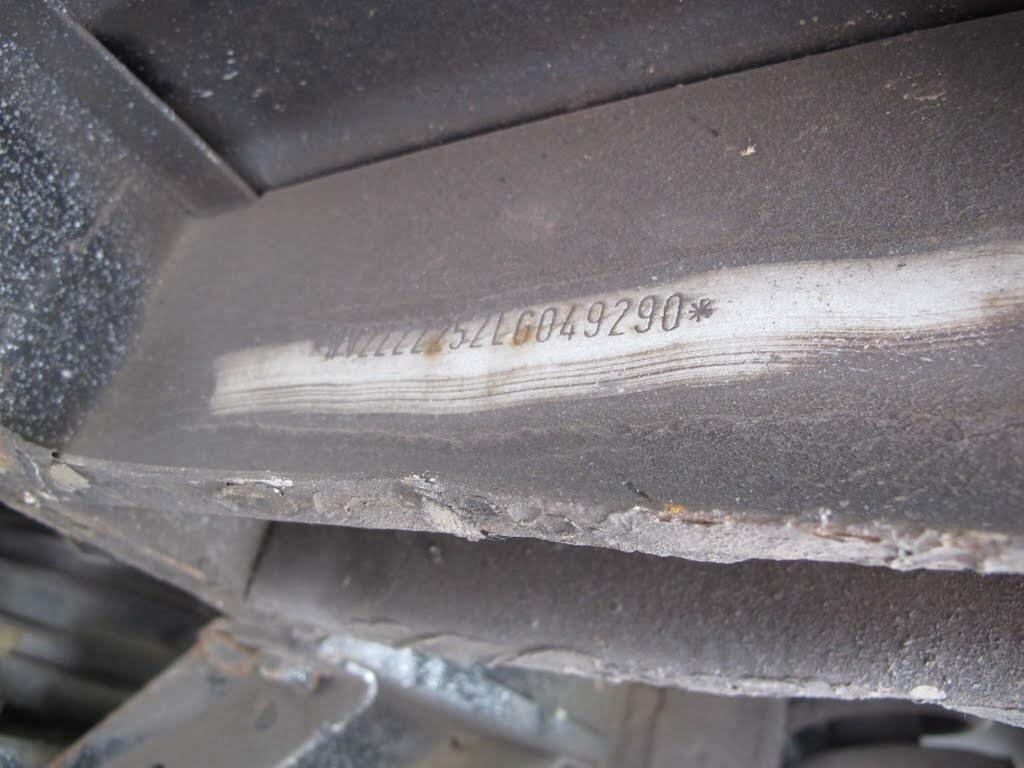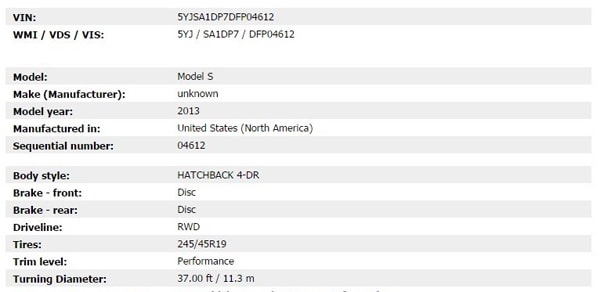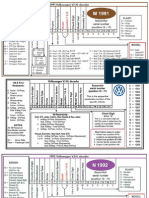This is Volkswagen VIN Decoder. Every Volkswagen has a Vehicle Identification Number (VIN). This number contains vital information about the vehicle, such as model, year of production, manufacturer, country and plant of assembly, type of engine, and more. Beetle VIN / Chassis Numbers Each chassis number is the last vehicle produced in that month. Beginning in August, 1955, the VW model years began in August of the previous year. Example: Aug., 1955=1956 model. Beginning in the 1965 model year (August 1964), the VIN/chassis number begins with the first 2-digits of the full model number. A vehicle identification number (VIN) is a unique code assigned to every motor vehicle when it's manufactured. The VIN is a 17-character string of letters and numbers without intervening spaces or the letters Q (q), I (i), and O (o); these are omitted to avoid confusion with the numerals 0 and 1. Aug 18, 2018 A VW VIN lookup is the first thing you should do before you buy a used Volkswagen vehicle. With a decent VW VIN lookup, you can detect whether the vehicle has been affected by the Volkswagen Emission Scandal. You can do a VW VIN lookup with a VIN decoder. A VIN lookup can help you to identify the original air cooled VW parts that came stock in.

The Volkswagen VIN number is an individual code of 17 characters, which allows you to learn a lot of important information about the vehicle. Importantly, decoding the VIN number in Volkswagen can help you find important information about the car you want to buy. The purchase of a Volkswagen used vehicle may involve a certain risk, but a VIN decoder will reveal detailed vehicle history. So how do you find the VIN in Volkswagen and how do you decode it? Read in our article.
Volkswagen – VIN number decoding
The Volkswagen body number encoding is good for people planning to buy a car, especially if the car is imported from abroad. The Volkswagen identification number helps to define such detailed technical parameters as country of production, model year, drive type, engine version and equipment options. However, it is important that verification of the body number allows you to search the database of stolen vehicles and get to know its full history such as the number of owners or potential accidents. As you can see, decoding the VIN in Volkswagen allows you to learn important information about the vehicle, so you can verify the data provided by the seller, for example, and reduce the risk associated with the purchase of a used car. If you want to find out whether the Volkswagen you are interested in is not an accident, decode the VIN using the form below.
Volkswagen – where to find VIN?
The first thing we should do before verifying the VIN is to check its location in the car and compare it with the VIN in the documents. At first glance, you can see some interference with the body number. However, finding a VIN in a Volkswagen may not be easy, as its location depends not only on the model, but also on the yearbook. If you’re wondering where the VIN is in a Volkswagen Golf, it was placed on a fixed part of the front bulkhead between 1998 and 2002. The 2003-2008 VIN number on the fixed component was placed on the front bulkhead and on the dashboard housing on the left, the VIN plate was placed on the middle left post. The models from 2008-2012 had the VIN number located in three places. The popular Passat has the VIN number plate on the front panel on the right and on the dashboard housing on the left. Younger yearlings from 2010-2013 have the VIN number on the fixed element located on the right side reinforcement and the VIN number plate on the middle pillar on the left. Equally common on our Polo roads is the VIN number plate on the left side reinforcement near the seat of the left shock absorber.
The location of the VIN number in Volkswagen regardless of whether we have an Amarok, Fox, Golf Plus, Sharan, Touareg, Touran or a Caddy or Crafter delivery truck may not be in an obvious location, so sometimes it is worth using proven tools so as not to waste time on a long search.

Volkswagen – checking the VIN number
Verification of Volkswagen’s technical data before purchase can be very helpful if you want to buy a car from abroad. Verification of the VIN number in Volkswagen will allow to confront the vehicle data placed by the manufacturer with information provided by the seller. In particular, those concerning Volkswagen’s construction, potential service repairs or mileage. So how to check the history of a Volkswagen vehicle? This can be done online by completing the form below. The basic version of the service is available free of charge, while those wishing to learn more about Volkswagen can use the full history report of the vehicle, which is paid for. However, the cost of the service is relatively small in relation to the price we can pay for a car with hidden problems.
Year Identification and Changes (1949 - 1979)
by Josh Rodgers
VIN Decoding:
For Sample VIN: 2-1-5-066378, we break it into four parts (A,B,C, and D).
'A' (2) being the Type of vehicle it is. Theabove example VIN is a Type 2.
'B' (1) is the second number or the Vehiclemodel type decoded below. The sample decodes to be a Panel Van.
'C' (5) is the second letter of the year ofmanufacturer. The sample being either a 1955, 1965, or 1975model.
'D' (066378) represents the last six digitsbeing the chassis number. In the example VIN this instance, thisvehicle's Chassis number is 66378.
IMPORTANT NOTE: The above system is accurate for'65 thru '79 models. On earlier models, the only reliable method ordetermining year model is by the Model Manufacture or Chassisnumber.
Vw Passat Vin Number Decoder
Vehicle Model Type
1 = Kastenwagen (Panel Van and later forhaving windows and/or top cut out for campers)
2 = Neunsitzer-bus or Achtsitzer-bus(Standard or Station Wagon 8-seater, 9-seater)
3 = Kombi (Kombi, Kombi for Fire Trucks, andCampmobile)
4 = Sondermodell (Special model, 8- and9-seater)
5 = Sondermodell (Special Model,7-seater)
6 = Pritschewagen (Single and Double Cabs,Pickup Truck)
7 = Krankenwagen (Ambulance)
8 = Siebensitzer Bus (7-seater bus)
9 = Pre-1950 for all models
Vehicle Model Changes, Chassis, and EngineNumbers
(All info is for August of the actual year of production unlessotherwise stated.)
1979 Chassis# 219 2153 964 (July) Engine# GE 0055786
2000cc, 72hp, AFC Fuel injection
Remarks:
(a)Last year of the beloved Baywindow.
(b)Vanagon starts Aug. 1979.
(c)Hydraulic lifters.
1978 Chassis# 218 2000 001 Engine# GE 0 007083
2000cc, 72hp, AFC Fuel injection
Remarks:
(a)Sliding rear windows.
(b)Hydraulic lifters.
1977 Chassis# 217 2000 001 Engine# GE 0 000001
2000cc, 72hp, AFC Fuel injection
Remarks:
(a)The last few produced for this year began hydrauliclifters.
1976 Chassis# 216 2000 001 Engine# CJ 0 000001
2000cc, 72hp, AFC Fuel injection
Remarks:
(a)The first year for the 2000cc (GD) engine.

1975 Chassis# 215 2000 001 Engine# AP 0 027466
1795cc, 68hp, AFC Fuel injection
Remarks:
(a) The first year for the AFC Fuel injection.
(b) First of bigger tranny
(c)
1974 Chassis# 214 2000 001 Engine# ?
1795cc, 68hp, Dual PDSIT -2 & -3
Remarks:
(a) Alternator replaces Generator
1973 Chassis# 213 2000 001 Engine# CA 0 020 001(CB 0 062 006)
1700cc, 66hp, Dual PDSIT -2 & -3
Remarks:
(a)First year with front signals just below windshield
(b)Smog pump and hoses...
(c)Heavier disc brakes and steering box
(d)Ovalled 'gill' engine air intake in upper rears turn rectangularas standard
1972 Chassis# 212 2000 000 Engine# CA (CB) 0 000001
1700cc, 66hp, Dual PDSIT -2 & -3
Remarks:
(a)First year of Pancake engine standard and hoses...
(b)Dual carbs
(c)Backup and tail lights under same lens
1971 Chassis# 211 2000 001 Engine# AE 0 000001
1600cc, 57hp, Solex 34 Pict -3
Remarks:
(a)Considered by most the Best of all the Bay-windowed models
(b)Disk brakes in front, composite rear drums
(c)Dual port head begin standard
(d)New dizzy with vacuum retard at idle
1970 Chassis# 210 2000 001 Engine# B 5 116437
1600cc, 57hp, Solex 30 Pict -1
Remarks:
(a)Squared side markers on front and back
1969 Chassis# 219 000 001 Engine# B 5 050174
1600cc, 57hp, Solex 30 Pict -1
Remarks:
(a)round side reflectors on front and back
(b)Trigger release outer door handles standard begins
Vw Bug Vin Number Decoder
1968 Chassis# 218 000 001 Engine# B 5 000001
1600cc, 57hp, Solex 30 Pict -1
Remarks:
(a)thumb button release outer door handles
(b)Ball-joint standard begins
(c)IRS tranny standard begins
(d)Large ovalled 'gill' engine air intake in upper rears
++++++BODY STYLE CHANGE FROM LATE BAY TO EARLYSPLIT++++++
1967 Chassis# 217 000 001 Engine# H 0 183373
1493 cc, 53 HP, Solex 30 PICT-1 carburetor
Remarks:
(a) Imported to US: 29,049
(b) Electrical system changed to 12 volts
(c) 2-speed windshield wipers introduced
(d) Rear hatch door widened
(e) Rear hatch lock integrated with lift handle; grip recess inbody is eliminated
(f) Lock and square key discontinued for fuel filler cap cover
(g) New door lock mechanism
1966 Chassis# 216 000 001 Engine# H 0 000001
1493 cc, 53 HP Solex 30 PICT-1 carburetor
Remarks:
(a) Imported to US: 40,198
(b) Press-button lock on rear hatch
1965 Chassis# 215 000 001 Engine# (?G?)8 785398
1493 cc, 53 HP Solex 30 PICT-1 carburetor
Remarks:
(a) Imported to US: 34,054
(b) Total Produced: 189,000+
(c) Front signals now amber in color
(d) New headlight housings
(e) New transmission
(f) Larger clutch plate (9-spring assembly)
(g) Chassis number changed to reflect model type (bus, pickup,etc.)
(h) (October) Cab doors fitted with fixed inner handle tofacilitate closing doors from inside the vehicle
(i) Inner door lock operating handle replaced by small lever(similar to the one on the inside of the sliding door)
1964 Chassis# 1 144 282 Engine# (?) G 8 264628
1493 cc, 51 HP Solex 28 PICT carburetor
Remarks:
(a) Imported to US: 41,051
(b) Total Produced: 200,000+
(c) Inside door handles reduced in size
(d) Rear hatch door widened
(e) Deluxe models no longer have rear corner windows
(f) 14-inch wheels introduced (previously 15-inch) Standard tirebecomes 7 X 14
1963 Chassis# 971 550 Engine# 6 914 251
1493 cc, 51 HP Solex 28 PICT carburetor
Remarks:
(a) Imported to US: 39,383
(b) Engine size increased to 1500 cc
(c) (April) Sliding side door available as option
(d) New brakes, rear axle and rear suspension
(e) New transfer case
(f) New front axle and front suspension
(g) (March) Engine air intake slots are pressed inwards (except SCand DC)
(h) (January) 28 PICT carburetor is fitted with electro-mechanicalcut-off valve
(i) (December) Engine access hatch support changed to double springwith two rollers
(j) (December) Cab door trim panels secured by snaps instead ofscrews
(k) (December) Outside door handles changed from pull-type topush-button
1962 Chassis# 802 986 Engine# 5 979 934
1300 cc, 40 HP Solex PCI carburetor
Remarks:
(a) Imported to US: 32,514
(b) (Oct 2nd) 1,000,000th Type 2 produced at Hannover factory
(c) Padded sun visors introduced (previously cardboard-likematerial)
(d) Gas gauge standard on all models
1961 Chassis# 614 456 (May) Engine# 5 000001
1300 cc, 40 HP Solex PCI carburetor
Remarks:
(a) Imported to US: 22,754
(b) Total Produced: 168,800
(c) New Ring/pinion unit in transmission
(d) Large oval front turn signals with plastic lenses replace'bullets'
(e) Larger rear turn signals/brake lights with plastic lenses
(f) 40 HP Started
1960 Chassis# 469 506 (June) Engine# 3 400000
1300 cc, 36 HP Solex PCI carburetor
Remarks:
(a) Imported to US: 35,697
(b) wide-bed pickup trucks available on special order
(c) High roof delivery van available
(d) 40 HP engine introduced in June (from chassis 614-456, engine5,000,001)
1959 Chassis# 374 811 Engine# ?
1300 cc, 36 HP Solex PCI carburetor
Remarks:
(a) Imported to US: 32,133
(b) Total Produced: 101,873
(c) Fully syncromesh transmission introduced (B-type)
1958 Chassis# 315 209 (Dec) Engine# 2 156321
1300 cc, 36 HP Solex PCI carburetor
Remarks:
(a) Imported to US: 25,036
(b) Total Produced: 101,873
(c) Double cab pickup model introduced
(d) Stronger bumpers introduced, with over-riders on U.S.models
(e) One-year only engine lid
1957 Chassis# 223 217 (Dec) Engine# 1 678210
1300 cc, 36 HP Solex PCI carburetor
Remarks:
(a) Imported to U.S.: 19,118
(b) Center brake light
(c) small circular taillights eliminated
(d) larger circular brake/tail lights on each side of therear

1956 Chassis# to 160 706 (Dec) Engine# ?
1300 cc, 36 HP Solex PCI carburetor
Remarks:
(a) Imported to U.S.: 7,375
(b) Semaphore turn signals eliminated on US models; 'Bullet' frontturn signals introduced on US models
(c) (April 19th) Chassis 20-178-004 was last Type 2 built inWolfsburg, new factory in Hannover begins production
1955 Chassis# to 110 604 (Dec) Engine# ?
1300 cc, 36 HP Solex PCI carburetor
Remarks:
(a) Imported to U.S.: 3,189
(b) (March) Front fresh air ventilation system introduced
(c) Full length dashboard
(d) All pedals changed
(e) Passenger 'footrest' eliminated
(f) (March) 15-inch wheels introduced (previously 16-inch).
(g) Standard tire becomes 6.40 x 15.
(h) Engine air louvers shortened
(i) Two-spoke steering wheel (previously three-spoke)
(j) Walk-through front seating available as an option
1953 Chassis # ? Engine# ?
1131 cc, 25 HP Solex PCI carburetor
Remarks:
(a) Imported to US: 75
(b) (March) Deluxe Microbus rear bumper as standard equipment(optional equipment on other models)
1952 Chassis# ? Engine# ?
1131 cc, 25 HP Solex PCI carburetor
Remarks:
(a) Imported to US: 93
(b) Total Produced: 20,366
(c) According to VWoA, 1952 was the first year the bus wasofficially imported into the U.S.
(d) (August) Single cab pickup introduced. Dropping side gates withsmooth sides. Fuel tank moved to a shelf behind the engine, withthe filler neck running out the side of the truck, in front of theright rear wheel well.
(e) Last year for piano hinge vent wings, smooth horn button andsplined steering wheel, T-handle heater knob, two fuse boxes, thethe 'shorty' parking brake handle.
(f) (October) Transmission gets synchronized gears in 2nd, 3rd, and4th.
1951 Chassis# ? Engine# ?
1131 cc, 25 HP Solex PCI carburetor
Remarks:
(a) Imported to US: 50
(b) Total Produced: 11,805
(c) (June) Deluxe Microbus introduced (nicknamed Samba) withSkylight windows and canvas sliding sunroof
(d) Westfalia camper model introduced
(e) Longer dashboard with radio and clock
(f) Carpeted area behind rear seat
(g) Chrome trim on body
(f) (December) Ambulance model introduced, with rear opening door,gas tank moved out of engine compartment, spare tire moved out ofengine compartment to behind front seat
(g) Rear window added
(h) Ventilation slats in upper rear corners were extended to matchthe engine compartment vents
(i) Rain gutters extended
(j) Inside cargo door handle added
(k) Front panel made in two pieces (not one piece)
1950 Chassis# ? Engine# ?
1131 cc, 25 HP Solex PCI carburetor
Remarks:
(a) Imported to US: 2
(b) Total Produced: 9,145
(c) (May) Additional Model, Microbus, introduced: nicer upholstery,two-tone paint
(d) Fuel filler moved inside engine compartment (does not stick outthe back)
(e) Upper front door hinges raised to the 'belt' line
(f) Engine lid prop moved from left side to right side of enginecompartment
(g) Engine air intakes made horizontal, instead of veritical
(h) Windshield wipers on both sides of windshield (driver andpassenger)
(i) (Later models) Front jack ports moved rearward for strongersupport
(j) (Later models) Ventilation louvers in upper back corner ofpanel van
(k) Shape of front bumper changed
(l) No rear bumper or rear window
(m) Big cast aluminum 'VW' logo on front and back
(n) All models have 16-inch wheels and come with 6.00 x 16tires.
1949 Chassis# ? Engine# ?
1300 cc, 36 HP Solex PCI carburetor
Remarks:
(a) Imported to US: 0
(b) (November) First Type 2 introduced (nicknamed: Bulle(Workhorse))
(c) Only models available: Kombi and Panel van
